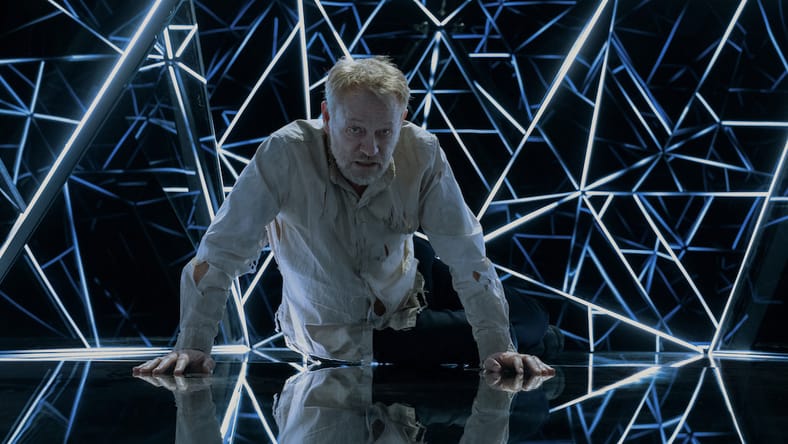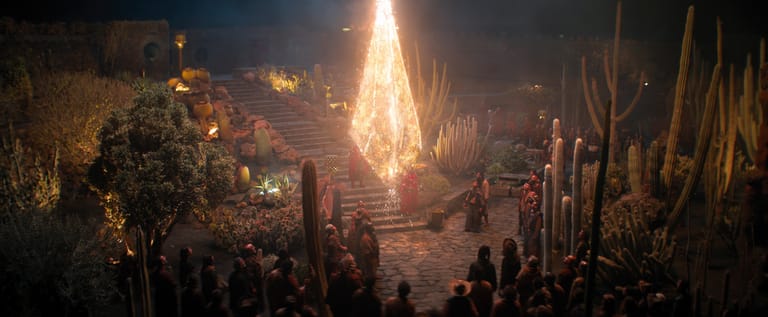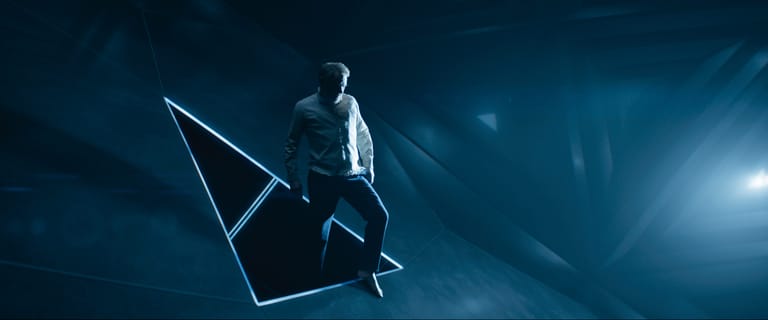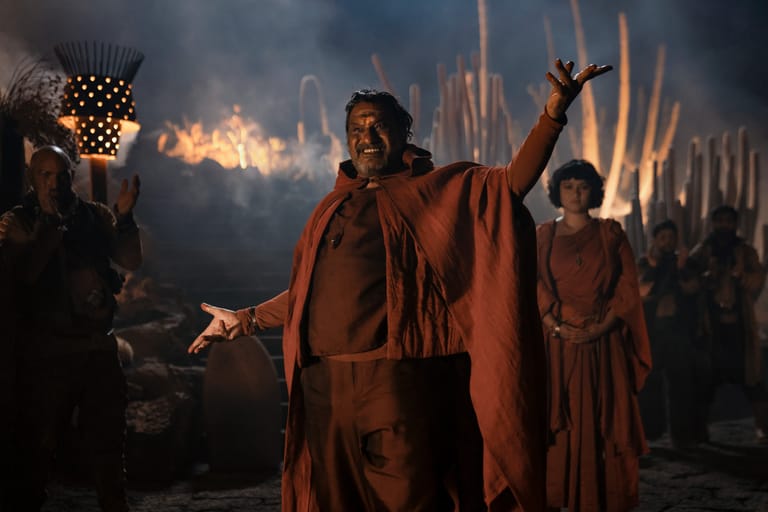
Foundation, the sweeping Apple TV+ series based on the work of Isaac Asimov, has some of the most distinctive cinematography in television, enveloping viewers in scenes that span worlds, centuries, and even dimensions. No other show looks anything like it.
But Foundation‘s wholly unique look — which combines a thrumming, glowing energy with a grounded sense of gravity — doesn’t come from a heavy hand. In fact, cinematographers Cathal Watters and Owen McPolin, who each shot four episode of the show’s 10-episode second season, say showrunner David Goyer and their directors allowed them notable creative freedom to tell the visual stories of Foundation.
“We didn’t have too many meetings, where it was like, ‘This is how it should look,’ said Watters.
McPolin noted that the show’s second season had many key artisans across the storyline, including costume designer Jane Petrie, production designer Rory Cheyne, and visual effects supervisor Chris MacLean, who earned an Emmy nomination for Season 2, one of two for the show.
The cinematographers also maintained consistency by both using Panavision Millennium DXL2 8K digital cameras, and the same lenses, Panavision Ultra Vista primes. And they could refer to Season 1 of Foundation.
“There is a certain harmony there in those elements,” said McPolin, speaking to us from Warsaw, Poland, where he is working on Foundation Season 3. “And then obviously we come in and we would interpret and we would create. We would speak the same language, but we might use a different grammar. And the director has their accent, and they bring their voice to it.”
As if to personify the idea of a shared language with slightly different accents, they are from nearly opposite ends of Ireland: Watters was born in Dublin, but raised in nearby County Meath, in the east, while McPolin is from Cork, in the south, but was raised in neighboring County Kerry, in the southwest. While they have never worked together before, they knew and admired each other’s work.
“Ireland is a small country, particularly in the film business,” says McPolin.

He grew up making films with friends, studied filmmaking in the UK, and returned home in the 1990s just as the Irish Film Board, now known as Screen Ireland, began promoting local films in earnest. “I caught a break,” he says. His best known projects have included the TV shows Vikings, Penny Dreadful, and another sweeping Goyer project, Da Vinci’s Demons.
Watters studied drama at Trinity College Dublin and then started shooting news, which led to filming documentaries, music videos, short films, films, and TV dramas. His best-known projects have included the shows Peaky Blinders and The Alienist.
“You hook up with good directors, and they bring you along, and they get the next gig. And so it is lots of perseverance, a lot of hard work, a bit of talent — and then lucky breaks get you a long way,” he laughed.
The Challenges and Freedoms of Shooting Foundation
Watters exclusively shot the Season 2 episodes directed by Alex Graves, including the season premiere and finale and episodes five and six. McPolin shot two episodes directed by Goyer — the second and third episodes of Season 2 — as well as two episodes directed by Roxann Dawson, the eighth and ninth episodes.
Watters said his biggest challenge in shooting Foundation was tracking the continuity of the visuals across all the episodes.
“One day, I did a scene from Episode 10, and in the same day, I did another scene from Episode 1,” he recalls. “How you get from here to there — trying trying to plan that visually — was obviously a massive challenge.”
Also Read: The Making of Furiosa (Cover Story)
The production was shot across Europe, in Ireland, the Canary Islands, and Prague. Watters, speaking from Dublin, where is working on the new CW show Sherlock & Daughter, said that he and the other cinematographers were left to their own devices to decide how to shoot a given location — but often compared notes.
“There were some shared sets, for sure,” he said. “We’d look at each other’s work. … we’d tell each other the pitfalls.”
They might share the trickier elements of lighting a certain interior, for example. But ultimately, Watters noted, “the lighting has to come from you, and how you want to tell the story, and the director wants to tell the story.”
That creative freedom was especially refreshing on a show with the massive scale and intense fanbase of Foundation. The series, inspired in part by the Roman Empire, has drawn a passionate following from audiences guessing at the next moves of Jared Harris’ prophetic Hari Seldon and Lee Pace’s regal Brother Day. They lead an ensemble cast across time and space.
“I think once or twice, I think they said, ‘Now listen, whatever you do in this set, we would like it to be somewhat similar. And we would like some certain continuity. But we leave that up to you,'” McPolin said. “And that’s what Goyer said: We’re not going to come down and say to you, don’t track in this set, or don’t use a crane, or don’t put a light from that side, we always go from that side.”
He continued: “There are certain shows in the U.S. and Britain where people say, ‘Oh, we always use symmetry, we never use a dolly, we always use a jib.’ And there’s a certain grammar, which I would argue are certain restraints that are placed that are placed upon filmmakers in general, because they think the show should be rigid, as opposed to harmonious.”
McPolin added: “No one ever put that straitjacket on us. … I think we all created something that was harmonious rather than work in a rigidity where we all try to imitate one another — which we would all be s— at.”
Foundation Set Pieces
Sometimes that freedom meant finding creative solutions to answer big questions about how a given scene should look. The opening of Season 2, for example, finds Seldon trapped inside the four-dimensional world of the Prime Radiant.
The script for the episode explained simply that Harry was in a dark place — a tough directive for a cinematographer trying to light the location. Watters came up with the idea to use flashes with decay to illustrated his torment.

The show built four Prime Radiant sets, one of which production designer Rory Cheyne designed as “basically an infinity mirror,” Watters said.
“It’s a life-size octagonal area with a tube out of it, and all of these LED lights are there. And we chose a glass that would have a certain reflective quality, so when you’re inside, and we light the LEDs, that was reflected against the glass, and that banged off the next piece of glass — and you’ve got this infinity view,” Watters explained.
Another of the Prime Radiant sets — the one Hari eventually walks free from — was a tall build with triangular walls. Watters rehearsed the lighting using his iPhone on a small model of the set before it was constructed.
“And suddenly all the shapes started moving across the floor,” Watters said. “Cut to six months later and I had two very brave electricians up on cranes, panning lights as they were pushed on these massive Giraffe cranes on track, moving over and back and the light was shining in, because I used my iPhone, trying to get a sense of how one would like these spaces.”
The effort paid off: Watters received a nomination from the ASC Awards, held by the American Society of Cinematographers, for his work on the episode, entitled “In Seldon’s Shadow.”
McPolin, meanwhile, was tasked on the second episode of the second season — entitled “A Glimpse of Darkness” — with turning day to night.
It happens when Brother Constant (Isabella Laughland), who is trying to spread the word of Hari Seldon in an outpost on the Outer Reach planet Siwenna, arrives in town and gets a hostile reception.
“There’s a line in the script, where Constant walk runs into town, she gets run out of town, and then literally in camera, it turns from day to night. So I turned around to the director, Goyer. I said ‘You want it to go from day to night, in an outside location, with 300 extras? And he went, ”Yeah.” So I looked at the gaffer, and he looked at me and says, ‘Come on, let’s have a chat about that. And we were banging our heads off a wall… And eventually we cracked it.”

He and gaffer Barry Conroy — whose credits also include The Lobster and Abigail — eventually came up with a solution. McPolin gives most of the credit to Conroy.
“He said, ‘Does it matter when it changes from day to night? And I was going, ‘Of course! Why don’t we just back it into the sunset — we take over the sunset. And then we turn off the sunset after dark.’ But we could only do that over a one-hour period. So we transitioned.
“We literally had, I think it was a SoftSun [light] and something like 10 20Ks on a rig to imitate where the sun disappeared behind it. And then that evening light took over from the real sun. And then we were able to transition that down, and brought up the nightlight, the moonlight.”
Adds Watters: “Incredible.”
Foundation is now streaming on Apple TV+.
Main image: Hari Seldon (Jared Harris) inside the Prime Radiant, shot by Cathal Watters on Foundation. Apple TV+.
Share:

